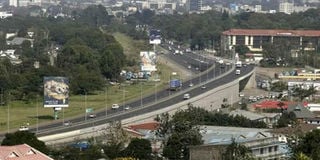Premium
Nakuru fortunes changing with Sh10bn roads projects

The landscape of Nakuru is fast-changing after the national government pumped in more than Sh10 billion to build and upgrade roads in the county.
Some of the projects are complete, while others are in advanced stages.
Already, the new roads in the region are slowly breathing life into quiet towns and outposts.
In Bahati Sub County, for instance, the Lanet-Dundori-Ol Kalou tarmac road has opened up the far-flung agricultural areas of Dundori.
The key road that connects Nakuru and Nyandarua County joins the busy Nairobi-Nakuru highway, at Lanet.
“Initially we could not access the market for our farm produce, but now we can easily access Nakuru town and other areas because of the road. Dundori, which used to be a rural outpost, is now open for investments,” said Mr Mathews Nderi, a resident of Dundori.
The road now serves farmers, who can easily access markets in both Nakuru town and Ol Kalou in Nyandarua.
The 65-kilometre Maili-Kumi-Lower Solai road, built at a cost of Sh2.4 billion, has also opened up the area for investments.
The road is expected to connect Subukia and Lower Solai.
The 126-kilometre Mauche-Bombo-Olenguruone-Kiptagich-Silibwet road, built at a cost of Sh3.5 billion from February 2017, is also complete.
Transportation of farm produce from the neighbouring counties of Narok and Kericho to Nakuru has been made easier, following completion of the key road.
Three interchanges that have been constructed along the Nairobi-Nakuru-Eldoret highway have also spruced up the face of Nakuru and neighbouring towns and eased traffic on the busy highway.
Construction of the interchanges at Mau summit junction, Kunste and Njoro turnoffs was completed last year.
The interchanges have given residents, businessmen and travellers a breather from years of traffic snarl-ups that last for hours.
The multi-billion projects were funded by the World Bank and supervised by the Kenya National Highways Authority (Kenha).
“These projects have opened up Nakuru town and improved traffic flow at Mau Summit, Njoro and Nyahururu turn-offs,” said Mr Koskei.
Mr Koskei added that the interchanges ease transport of farm inputs, finished products and supplies.
Nyahururu is known for horticulture, floriculture and vegetable farming, while parts of Nakuru County, including Njoro and Mau Summit, produce dairy products, potatoes and vegetables.
Kenha’s assistant director in charge of Corporate Communications, Mr Charles Njogu, in an interview with the nation.africa, said the projects are part of the authority’s activities aimed at improving the state of highways in the country.
“Completion of the projects will provide requisite development stimulus through reduced transport costs and travel times, reductions in vehicle operating costs and increased speeds,” said Mr Njogu.
Traffic snarl-ups, sometimes stretching to almost five kilometres on both sides of the highway, are a common phenomenon on the route, often forcing motorists to use alternative routes.
For instance, private cars, public service vehicles, and even heavy commercials are forced to divert from the highway to avoid heavy traffic jams heading from Nakuru to Nairobi.
“Before the construction of the Kunste interchange, motorists in Bahati would be stuck in traffic from Nakuru town for over two hours, a distance of about six kilometres, but now it takes less than 20 minutes,” said Mr Njogu.
Other key roads in Nakuru that are under construction are; the Sh1.5 billion 23-kilometre Gilgil-Machinery road and the Sh800 million 23-kilometre Elementaita-Mau Narok Road that is now 76 per cent complete.
Maintenance of the Naivasha-Narok and Mai Mahiu-Narok roads is going on, at a cost of Sh289.9 million and Sh288 million respectively.
Other road construction projects in Nakuru are Molo-Kibunja (Sh478 million), Salgaa-Rongai (Sh252.5 million), Subukia-Shrine (Sh241 million), Mau-Summit-Junction (Sh199 million) and Maraigishu-Kinungi (Sh41 million) and Mang’u-Berer (Sh40 million).
Upgrading of the Naivasha-Karagita-Kongoni Road that links up the Moi South lake road, which hosts dozens of camping sites and lake resorts, has also boosted tourism in Nakuru.
The government also plans to rehabilitate the Njoro-Elburgon-Molo Road at a cost of Sh333 million.
Property owners are also happy with the revamped road network, saying this will attract investors.
With the new developments, Nakuru is experiencing growth and influx of industrial investments, even as it eyes an industrial revolution at the Naivasha Special Economic Zone.
The government has also allocated more than Sh400 million in the current financial year, for the Sh3 billion airport upgrade project at the 81 Tank Battalion Barracks in Lanet project with a promise of additional funding in subsequent years.
The road projects are a big boost to development through reduced transport costs and travel times, reductions in vehicle operating costs and increased speeds, according to government spokesperson Colonel (Retired) Cyrus Oguna.
“The government seeks to improve transport, open up rural outposts as well as boost agriculture and trade in various places in Nakuru. The development of big and successful economies has always been connected to infrastructural expansion and as a government, we are making substantial investments in the infrastructure sector to achieve growth, “said Mr Oguna.
“The road projects will have a direct impact on the manufacturing, horticultural, tourism and hospitality sectors. The government is committed to making the Big Four agenda a reality,” he added.





